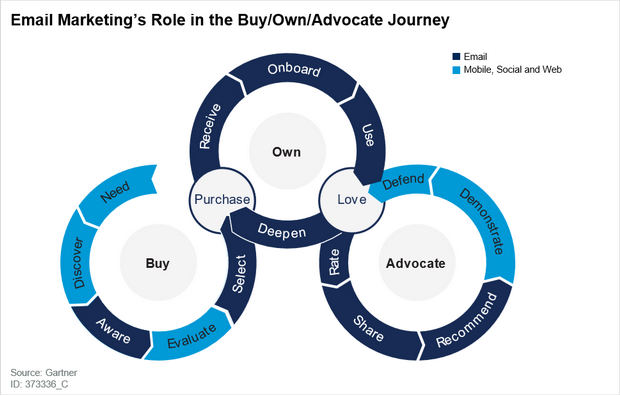Email marketing remains a key activity for marketing leaders today, and with good reason. It’s a channel that continues to prove its effectiveness in contributing value for businesses and help you stand out. You shouldn’t underestimate the importance of email marketing: its measurable and will help you gain customer insights.
Playing a fundamental role at every stage of the buyer journey, email marketing will deepen customer relationships. You can use email to build awareness and progress buyers along the various points of the buyer journey. For more details on the buyer journey. Gartner defines the different stages of the buyer journey and where email can contribute in the figure below.
- Awareness: Increasing brand recognition
- Interest: Influencing brand preference among competitive alternatives
- Convert: Converting interested audiences to paying customers
- Advocate: Transforming customers into repeat purchasers and brand promoters
Whats in your inbox
Email is frequently the starting point of any multichannel marketing efforts. Its often the glue that binds all other marketing activities. An essential building block for your integrated marketing activities.
Customers and prospects who have voluntarily provided you with their email address have given you explicit consent for you to communicate with theme. This doesn’t mean you should squander that trust by bombarding them. This behaviour is more likely to drive them to remove that trust and unsubscribe.
This means that what lands in a recipient’s inbox must be of interest and value to them.
As much as you’re keen for an email to land in someone’s inbox, its really important to make sure you aren’t sending them an email just for the sake of it. With more or us working from home, its true that our behaviour has changed. We are opening more emails than before: 30% more mails. Whatever lands in someone’s inbox should have a purpose.
Remember it’s all about the value to the recipient, not you! Obviously you do have an ultimate goal as a business.
How to write a killer email
Here are five key steps to achieving effective email marketing
1. Personalisation
 Take the time to develop a robust understanding of your customer profiles or customer personas. Email marketing will help you learn more about them, but you need to understand them in order to better personalise any email you send.
Take the time to develop a robust understanding of your customer profiles or customer personas. Email marketing will help you learn more about them, but you need to understand them in order to better personalise any email you send.
Segmenting your target audience based on their interests, roles, or challenges means you can better speak to them at an individual level.
Wherever possible personalize the email by connecting to something specific about the person, where they work, what’s happening in their market place.
Most importantly be very clear who you’re speaking to before you start writing. If you don’t know who you want to read your email, your message will not be read, diluted or worst of all just not read at all.
2. emphasize benefits to the reader
You need to know what you’re trying to achieve or your desired outcome with your email. There are a lot of different types of emails, check out our Beginners Guide to successful email marketing.
This might be a special offer, which is about making a sale, your newsletter is more about adding value and keeping your brand and business front of mind (remembering that you still need to deliver value for the reader). Engagement and nurturing might be more about building your understanding of your recipient or engaging them further with your business.
Whatever the reason, you need to make a connection between the content or subject and the reader.
3. Create a catchy subject line
This is easier said than done, but it’s the first thing your audience will see in their inbox and will determine whether on not they open your email. If your subject line is not good enough, its simple, no one will read the content that you’ve sent them.
What this is and the approach will depend on your audience and what type of busines you are trying to reach. Humour can work, but be cautious with this. Urgency may work for offers, promotions or confirmations.
In general, try to keep your subject line short, as you need to think mobile-first, as recipients may catch up on emails using mobile devices. Ideally keep to no more than 70-80 characters and put the most important message at the front. Depending on your busines audience, emojis can also improve open rates, but use these with caution.
4. Make it short and sweet
There is no exact science on how long an email should be. It does really depend on a lot of factors, but worth remembering that text that appears further down the email is increasingly less likely to be read. Your opening words and paragraph are the most important to get the reader to continue reading what you’ve sent them.
Obviously, there are different styles and layouts – just look at your own inbox. Some that simply use text, others with some imagery, others delivered in magazine or newspaper style. Why not experiment and see what works best for your business.
But if you’re in doubt, less is more when it comes to email content, don’t overload the reader. You don’t need many words, just the right ones.
5. Whats your call to action (CTA)?
Whatever the intended goal of your email, don’t leave it to chance. Don’t assume that people will take the action you want them to. You need to guide them with an appropriate prompt. Although we are reading more emails at the moment, people will still quickly skim read the content, starting with the subject line, so make your CTA obvious.
email Art and Science
Getting it right for your business and your target audience can take time. Make the time to measure the results of your emails and test out new approaches, but always remember the five key steps. What works well for one business may not for another. Also remember that this is a human to human interaction so always consider the reader.
Sign up to receive regular marketing tips and ticks that will help your business.






